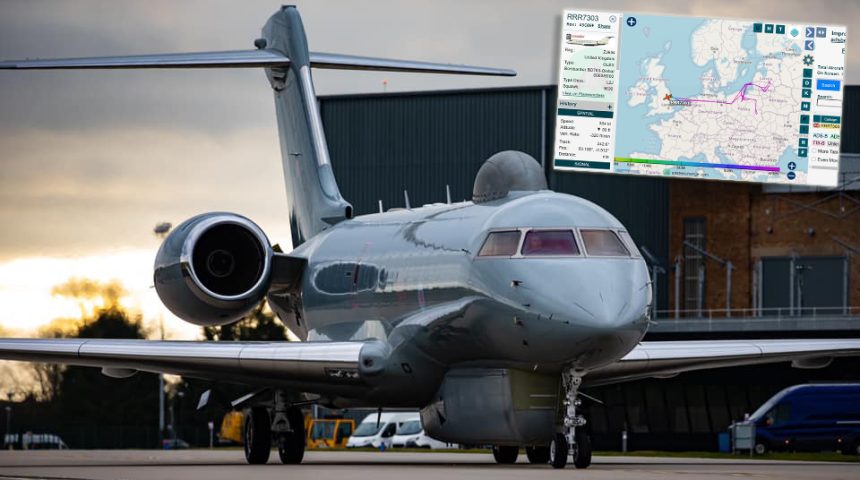The last mission of RAF Sentinel R1 ZJ694 was near Kaliningrad Oblast and Belarus. RAF will complete the retirement of the type by the end of March.
On Feb. 25, 2021, the RAF Sentinel R1 ZJ694 flew its last sortie before retirement. The touch down of mission RRR7303 (“ASCOT 7303”) at RAF Waddington marked the end of 13 years of RAF service for this airframe.
The final mission of ZJ694 could be entirely tracked online. The aircraft operated in one of the regions that have more frequently been watched by the long-range, wide-area battlefield surveillance platform. In fact, RRR7303 flew towards the Baltic and, operating inside NATO airspace of Poland and Lithuania, carried out surveillance activities off Russia’s Kaliningrad semi-exclave, and then close to Belarus. RAF Sentinels have been frequent visitors of the Baltic airspace, often sparking the reaction of the Russian Su-27 Flankers based in Kaliningrad.
RAF Sentinel R1 surveillance aircraft ZJ694 flew its last Op sortie today to a certain Baltic enclave. A capability gap to follow…?🤷♂️Superb pic below by @RAFPhotog https://t.co/NX7TE9xs8N pic.twitter.com/p5dhq1l7af
— Saint1 (@Saint1Mil) February 25, 2021
The Sentinel R1 is a long-range, wide-area battlefield surveillance aircraft, delivering critical intelligence and target tracking information to British and coalition forces. It has been operationally deployed in support of operations in Afghanistan, Libya, Mali, and, more recently, Iraq and Syria.
Here’s how the RAF website describes the aircraft:
Using its powerful multi-mode radar, the Sentinel’s mission crew identifies, tracks and images numerous targets over great ranges, passing the information in near real time to friendly forces. A team of intelligence imagery analysts from 1 Intelligence, Surveillance, Reconnaissance (ISR) Wing backs up the Sentinel crews, conducting in-depth forensic analysis of collected data, and using it to generate intelligence products for time-critical dissemination to commanders and decision makers, enabling them to execute current operations and plan future strategies.
The aircraft immediately proved its worth over Afghanistan and again during Operation Ellamy in 2011, becoming a vital link in the chain of target identification and prosecution, especially where fleeting or ‘pop-up’ targets were concerned. The 2010 Strategic Defence and Security Review nominated Sentinel for withdrawal as soon as the Operation Herrick commitment ended, but such was the system’s value to British and allied commanders that it was given a reprieve. Since then it continues to prove its worth in Operation Shader and as a result of the 2015 Strategic Defence and Security Review, its out of service date has been moved back to 2021.
Indeed, in May 2020, one week before a Sentinel made the news for being intercepted by Russian Flankers over the Black Sea, the British Ministry of Defence was asked about the service life of the type. Jeremy Quin, Minister of State at the M.o.D., confirmed that the aircraft would be retired in March 2021 due to “increasing obsolescence” after important upgrades were cancelled by the 2010 Defence Review. The retirement of the Sentinel leaves the U.K. without a long-range, wide-area battlefield surveillance capability as a replacement has not been yet determined. Here is an extract of the official statement:
“Sentinel was introduced in 2008 in the knowledge that a significant equipment upgrade would be required in the mid 2010’s. The Defence Review in 2010 cancelled this expected upgrade bringing forward the likely out of service date. The SDSR 2015 determined that Sentinel should be retained for a further period and set a new out of service date of March 2021. While some work was conducted on the on-board equipment this fell well short of a full system upgrade. The radar and mission system are now increasingly obsolescent and will face increasing reliability issues as time progresses. Retaining the capability would have required significant upgrade expenditure and the March 2021 out of service date has been retained. No identical capability is operated by the UK (though similar capabilities exist in the NATO inventory).”
The Royal Air Force is due to complete the retirement of the four remaining Sentinels by the end of next month.









